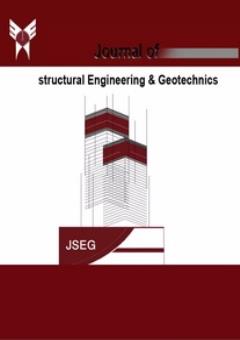Developing a Cost-Effective Approach for Enhancing the Rheological and Mechanical Behavior of High Strength Self-Compacting Concrete
محورهای موضوعی : Structural EngineeringSahand Mardi 1 , Morteza Bastami 2
1 - aDepartment of Civil Engineering, Qazvin Branch, Islamic Azad University, Qazvin, Iran
2 - Department of Structure, International Institute of Earthquake Engineering and Seismology (IIEES), Tehran, Iran
کلید واژه: High Strength Concrete, Economic Analysis, self-compacting concrete, Silica-Fume,
چکیده مقاله :
Despite the numerous advantages of using concrete with high strength capacity, the brittle behavior of high strength concrete (HSC) and higher production cost has limited its use in the construction industry. This research aims to develop a cost-effective approach for production of high strength self-compacting concrete with desirable performance in either compressive or tensile loading condition. To reach this purpose, 18 mixtures were cast initially with different w/c, binder, and silica-fume percentages. The results show that it is possible to produce high strength self-compacting concrete economically without using any additives such as silica-fume. Afterward, an innovative reinforcing technique using hexagonal wire mesh (HWM) were introduced for enhancing the HSC performance. The results show that HWM is able to enhance HSC behavior in both tensile and compressive loading condition. Finally, an economic analysis was conducted and the optimum HWM properties are selected according to the analysis results.
[1] State-of-the-art Report on High-Strength Concrete. ACI 363R-92, American Concrete Institute Committee 363, Farmington Hills, MI. 1992.
[2] Report on High-Strength Concrete. ACI 363R-10, American Concrete Institute Committee 363, Farmington Hills, MI. 2010.
[3] S. B. Singh, P. Munjal, and N. Thammishetti, “Role of water/cement ratio on strength development of cement mortar,” J. Build. Eng., vol. 4, pp. 94–100, Dec. 2015.
[4] S. Zhutovsky and K. Kovler, “Influence of water to cement ratio on the efficiency of internal curing of high-performance concrete,” Constr. Build. Mater., vol. 144, pp. 311–316, Jul. 2017.
[5] J. C. Lim and T. Ozbakkaloglu, “Influence of silica fume on stress–strain behavior of FRP-confined HSC,” Constr. Build. Mater., vol. 63, pp. 11–24, Jul. 2014.
[6] B. H. AbdelAleem and A. A. A. Hassan, “Development of self-consolidating rubberized concrete incorporating silica fume,” Constr. Build. Mater., vol. 161, pp. 389–397, Feb. 2018.
[7] J. J. Chen, P. L. Ng, L. G. Li, and A. K. H. Kwan, “Production of High-performance Concrete by Addition of Fly Ash Microsphere and Condensed Silica Fume,” Procedia Eng., vol. 172, pp. 165–171, Jan. 2017.
[8] Y. Ju, K. Tian, H. Liu, H.-W. Reinhardt, and L. Wang, “Experimental investigation of the effect of silica fume on the thermal spalling of reactive powder concrete,” Constr. Build. Mater., vol. 155, pp. 571–583, Nov. 2017.
[9] M. Benaicha, X. Roguiez, O. Jalbaud, Y. Burtschell, and A. H. Alaoui, “Influence of silica fume and viscosity modifying agent on the mechanical and rheological behavior of self compacting concrete,” Constr. Build. Mater., vol. 84, pp. 103–110, Jun. 2015.
[10] EFNARC, Specifications and Guidelines for Self-Compacting Concrete, EFNARC, UK, pp. 1–32, 2002.
[11] AFGC. Recommandations pour l’emploi des bétons autoplaçants; Janvier 2008.
[12] R. Abaeian, H. P. Behbahani, and S. J. Moslem, “Effects of high temperatures on mechanical behavior of high strength concrete reinforced with high performance synthetic macro polypropylene (HPP) fibres,” Constr. Build. Mater., vol. 165, pp. 631–638, Mar. 2018.
[13] W. Abbass, M. I. Khan, and S. Mourad, “Evaluation of mechanical properties of steel fiber reinforced concrete with different strengths of concrete,” Constr. Build. Mater., vol. 168, pp. 556–569, Apr. 2018.
[14] E. Molaei Raisi, J. Vaseghi Amiri, and M. R. Davoodi, “Influence of rice husk ash on the fracture characteristics and brittleness of self-compacting concrete,” Eng. Fract. Mech., vol. 199, pp. 595–608, Aug. 2018.
[15] M. Pourbaba, E. Asefi, H. Sadaghian, and A. Mirmiran, “Effect of age on the compressive strength of ultra-high-performance fiber-reinforced concrete,” Constr. Build. Mater., vol. 175, pp. 402–410, Jun. 2018.
[16] W. Xue, L. Li, B. Cheng, and J. Li, “The reversed cyclic load tests of normal and pre-stressed concrete beams,” Eng. Struct., vol. 30, no. 4, pp. 1014–1023, Apr. 2008.
[17] H.-O. Shin, K.-H. Min, and D. Mitchell, “Confinement of ultra-high-performance fiber reinforced concrete columns,” Compos. Struct., vol. 176, pp. 124–142, Sep. 2017.
[18] B. Boulekbache, M. Hamrat, M. Chemrouk, and S. Amziane, “Flexural behaviour of steel fibre-reinforced concrete under cyclic loading,” Constr. Build. Mater., vol. 126, pp. 253–262, Nov. 2016.
[19] A. P. Lampropoulos, S. A. Paschalis, O. T. Tsioulou, and S. E. Dritsos, “Strengthening of reinforced concrete beams using ultra high performance fibre reinforced concrete (UHPFRC),” Eng. Struct., vol. 106, pp. 370–384, Jan. 2016.
[20] ASTM C39 / C39M-18, Standard Test Method for Compressive Strength of Cylindrical Concrete Specimens, ASTM International, West Conshohocken, PA, 2018, www.astm.org.
[21] ASTM C1611 / C1611M-14, Standard Test Method for Slump Flow of Self-Consolidating Concrete, ASTM International, West Conshohocken, PA, 2014, www.astm.org.
[22] ASTM C1621 / C1621M-17, Standard Test Method for Passing Ability of Self-Consolidating Concrete by J-Ring, ASTM International, West Conshohocken, PA, 2017, www.astm.org.
[23] ASTM C1610 / C1610M-17, Standard Test Method for Static Segregation of Self-Consolidating Concrete Using Column Technique, ASTM International, West Conshohocken, PA, 2017, www.astm.org.
[24] ASTM C150 / C150M-17, Standard Specification for Portland Cement, ASTM International, West Conshohocken, PA, 2017, www.astm.org.
[25] ASTM C494 / C494M-17, Standard Specification for Chemical Admixtures for Concrete, ASTM International, West Conshohocken, PA, 2017, www.astm.org.
[26] ASTM A975-11(2016), Standard Specification for Double–Twisted Hexagonal Mesh Gabions and Revet Mattresses (Metallic-Coated Steel Wire or Metallic-Coated Steel Wire With Poly(Vinyl Chloride) (PVC) Coating), ASTM International, West Conshohocken, PA, 2016, www.astm.org.


